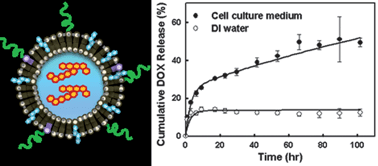Organic–inorganic nanovesicles for doxorubicin storage and release†
Abstract
The potential of organic–inorganic liposomal cerasomes to store and release

* Corresponding authors
a
Department of Aerospace and Mechanical Engineering, University of Arizona, Tucson, AZ 85721, USA
E-mail:
xwu@email.arizona.edu
Fax: +1-00-520-621-8191
Tel: +1-00-520-626-5854
b
Department of Biomedical Engineering, College of Engineering, Peking University, Beijing 100871, People's Republic of China
E-mail:
zhfdai@coe.pku.edu.cn
c Biomedical Engineering and Bio5 Institute, University of Arizona, Tucson, AZ 85721, USA
The potential of organic–inorganic liposomal cerasomes to store and release

 Please wait while we load your content...
Something went wrong. Try again?
Please wait while we load your content...
Something went wrong. Try again?
S. L. Leung, Z. Zha, W. Teng, C. Cohn, Z. Dai and X. Wu, Soft Matter, 2012, 8, 5756 DOI: 10.1039/C2SM07452D
To request permission to reproduce material from this article, please go to the Copyright Clearance Center request page.
If you are an author contributing to an RSC publication, you do not need to request permission provided correct acknowledgement is given.
If you are the author of this article, you do not need to request permission to reproduce figures and diagrams provided correct acknowledgement is given. If you want to reproduce the whole article in a third-party publication (excluding your thesis/dissertation for which permission is not required) please go to the Copyright Clearance Center request page.
Read more about how to correctly acknowledge RSC content.
 Fetching data from CrossRef.
Fetching data from CrossRef.
This may take some time to load.
Loading related content
